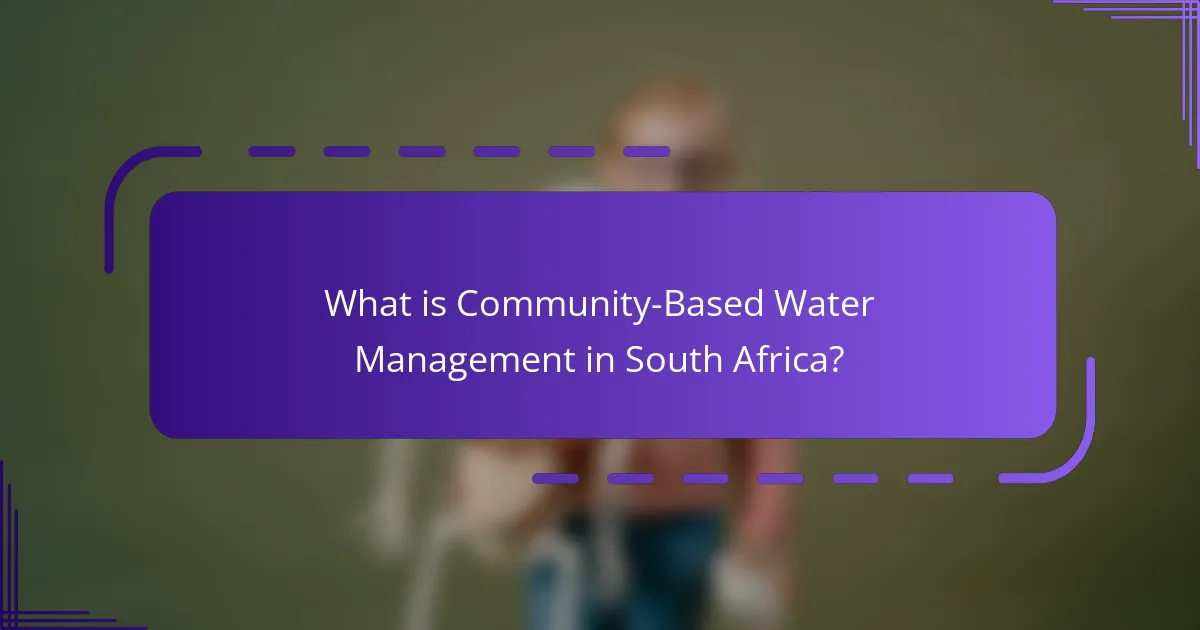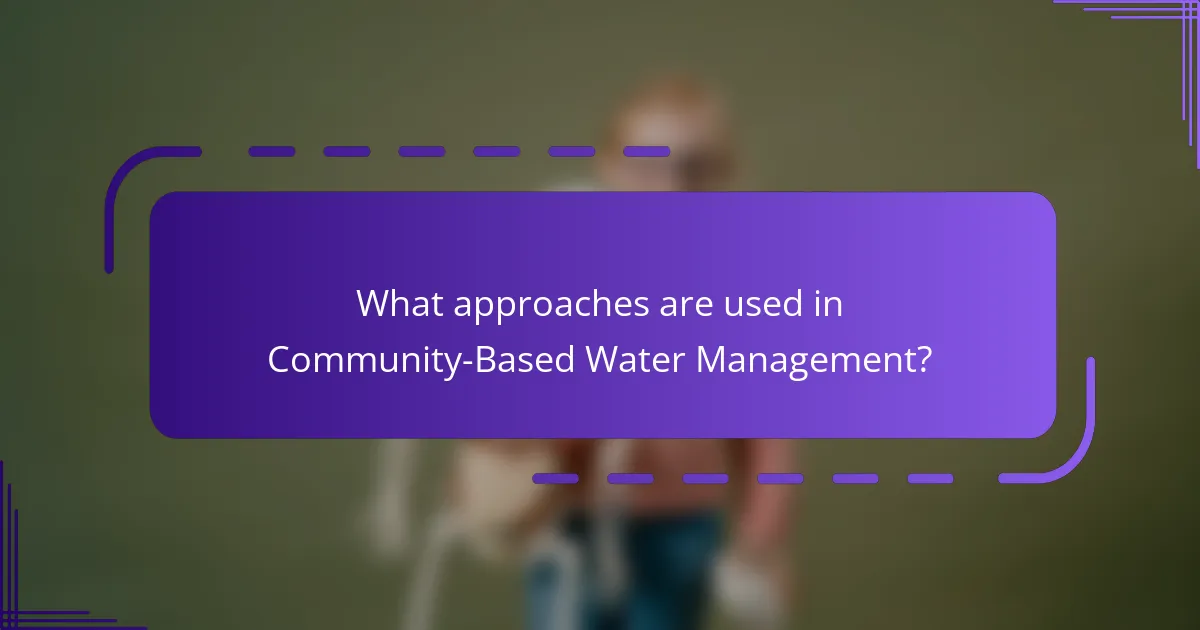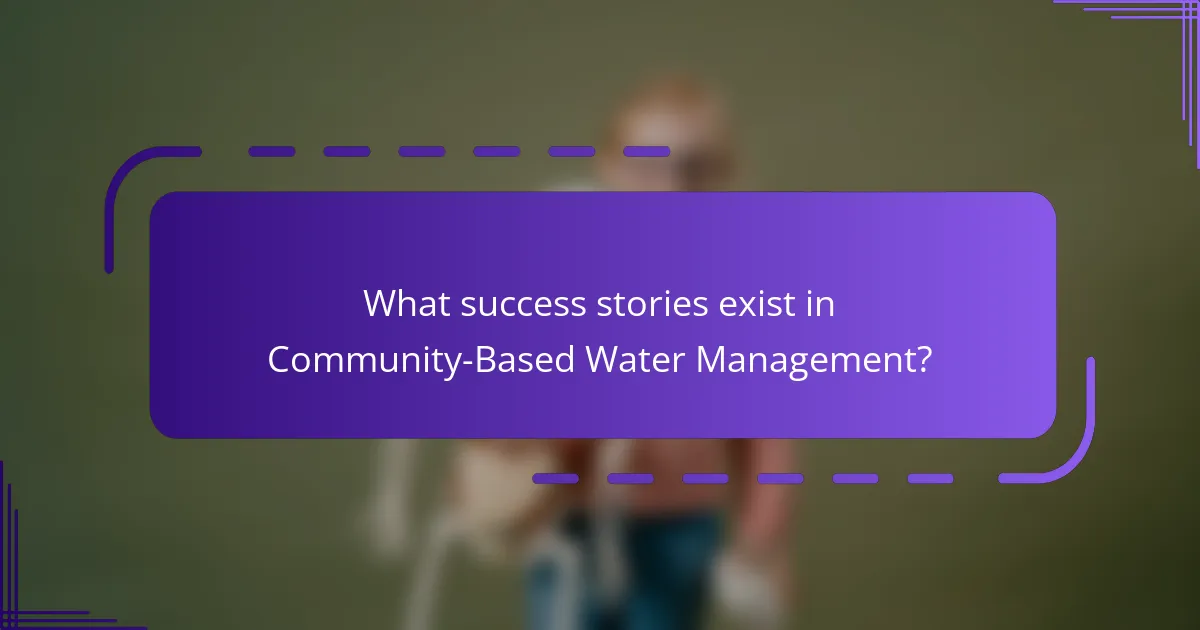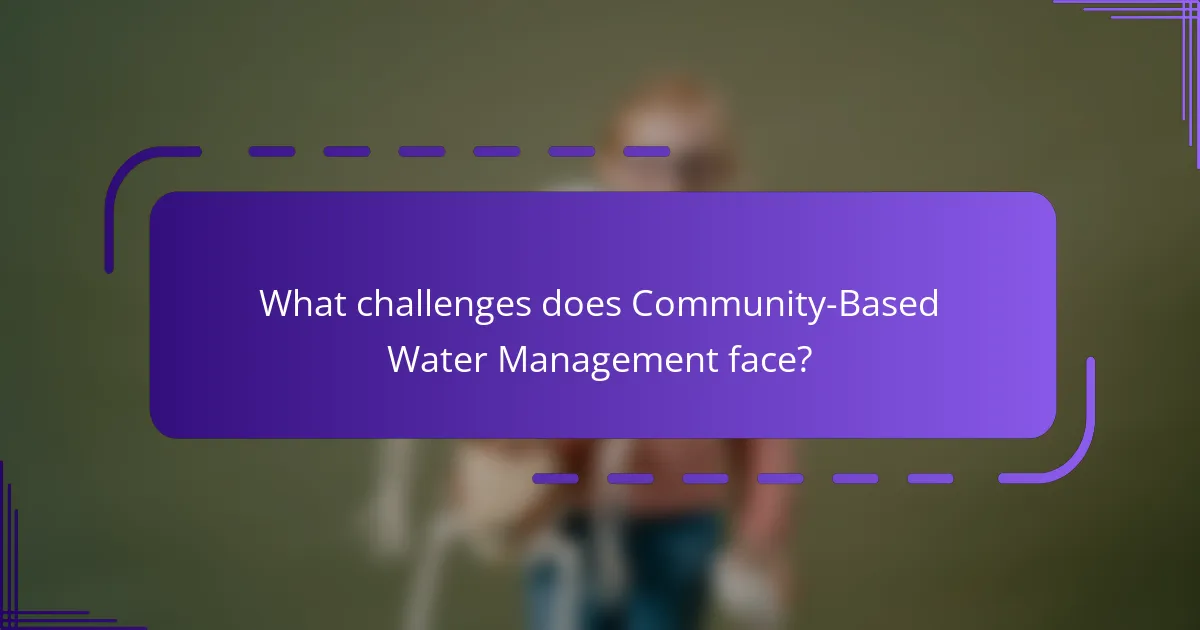Community-Based Water Management in South Africa is a participatory approach that involves local communities in the decision-making processes related to water resource management. This method aims to empower communities and enhance sustainable practices by incorporating local knowledge and needs. The article outlines various approaches used in this management strategy, including participatory planning, capacity building, and integrated water resource management. It also highlights successful initiatives, such as the Mvula Trust and the Water Services Authority in the Eastern Cape, which have improved water access and quality for communities. Additionally, the article discusses the challenges faced in implementing community-based water management, including financial limitations, technical expertise gaps, and conflicts over water rights.

What is Community-Based Water Management in South Africa?
Community-Based Water Management in South Africa is a participatory approach to managing water resources. This method involves local communities in decision-making processes regarding water use and conservation. It aims to empower communities and enhance sustainable water management practices. Local stakeholders contribute their knowledge and needs, leading to more effective water management solutions. Studies show that community involvement improves water quality and access. For instance, the Department of Water and Sanitation highlights successful projects in rural areas. These initiatives have increased water supply reliability and improved community health outcomes.
How does Community-Based Water Management function in local contexts?
Community-Based Water Management (CBWM) functions by involving local communities in the decision-making process regarding water resources. This approach empowers residents to manage their water supply sustainably. Local stakeholders assess their water needs and develop strategies tailored to their specific contexts. They often form committees to oversee water distribution and maintenance. These committees ensure that water management aligns with community priorities. Research shows that CBWM leads to improved water quality and access. In South Africa, successful examples demonstrate increased community engagement and better resource management. Studies indicate that areas with CBWM report higher satisfaction among residents regarding water services.
What are the key principles of Community-Based Water Management?
The key principles of Community-Based Water Management (CBWM) include participation, sustainability, and equity. Participation ensures that community members are actively involved in decision-making processes. This involvement fosters a sense of ownership over local water resources. Sustainability focuses on managing water resources in a way that meets current needs without compromising future generations. This principle helps maintain the ecological balance. Equity emphasizes fair access to water for all community members. It addresses disparities and ensures that vulnerable groups are considered in water management. Together, these principles guide effective water management practices in communities.
How does local governance influence Community-Based Water Management?
Local governance significantly influences Community-Based Water Management (CBWM) by facilitating local decision-making and resource allocation. Local governments establish regulations that shape water management practices. They also engage communities in planning and implementation processes. This involvement fosters accountability and ownership among community members. For instance, effective local governance can lead to improved water quality and accessibility. Research shows that communities with strong local governance structures report higher satisfaction with water services. Additionally, local governance can mobilize resources for infrastructure development, enhancing CBWM outcomes.
What are the historical contexts of Community-Based Water Management in South Africa?
Community-Based Water Management in South Africa has historical roots in the country’s socio-political landscape. During apartheid, marginalized communities faced significant water access challenges. In the post-apartheid era, policies shifted towards inclusive water governance. The 1998 Water Services Act emphasized community participation in water management. This legislative framework aimed to empower local communities in decision-making processes. Various initiatives have emerged since then, promoting sustainable practices. Notable examples include the establishment of water user associations. These associations facilitate local management of water resources. Overall, historical contexts reflect a transition from exclusion to community empowerment in water management.
How has the approach evolved over the years?
The approach to community-based water management in South Africa has evolved significantly over the years. Initially, water management was centralized and top-down, limiting community involvement. In the late 1990s, policies began to shift towards more inclusive practices. The 1998 Water Services Act emphasized community participation in decision-making. This transition aimed to empower local communities and improve service delivery. By the 2000s, numerous pilot projects demonstrated the effectiveness of community-led initiatives. Success stories emerged, showcasing enhanced water access and management. Recent strategies focus on sustainability and resilience against climate change impacts. These changes reflect a growing recognition of local knowledge and the importance of stakeholder collaboration.
What role did apartheid play in shaping water management practices?
Apartheid significantly influenced water management practices in South Africa. During apartheid, the government prioritized water access for white communities while neglecting black and marginalized populations. This led to unequal distribution of water resources. The apartheid regime implemented policies that restricted black communities’ access to water infrastructure. As a result, many black South Africans relied on inadequate and unsafe water sources. The legacy of these practices continues to affect water management today. Historical inequities have created challenges for equitable water access post-apartheid. Addressing these issues is crucial for effective community-based water management in South Africa.

What approaches are used in Community-Based Water Management?
Community-Based Water Management employs several approaches to effectively manage water resources. These include participatory planning, where community members are actively involved in decision-making processes. Capacity building is another approach, enhancing the skills and knowledge of local stakeholders. Integrated water resource management ensures that water is managed in a holistic manner, considering various factors like land use and ecosystem health.
Furthermore, stakeholder collaboration fosters partnerships among community members, government, and NGOs. Sustainable practices are promoted to ensure long-term water availability. Monitoring and evaluation mechanisms are established to assess the effectiveness of management strategies. These approaches collectively aim to empower communities and promote sustainable water use.
What are the various models of Community-Based Water Management?
The various models of Community-Based Water Management include decentralized management, participatory management, and co-management. Decentralized management empowers local communities to control water resources directly. Participatory management involves stakeholders in decision-making processes. Co-management combines government and community efforts for shared resource management. Each model promotes local engagement and sustainability. Research shows that these models can improve water access and quality in communities. For instance, decentralized management in South Africa has led to better resource allocation and community satisfaction.
How do these models differ in implementation?
The models of community-based water management in South Africa differ in implementation through their organizational structures and stakeholder involvement. Some models emphasize local governance, empowering communities to manage resources directly. Others rely on partnerships with governmental agencies or NGOs for oversight and support. The degree of community participation also varies, with some models allowing for extensive local input while others impose top-down directives. Additionally, resource allocation methods differ; some models prioritize equitable distribution, while others may focus on efficiency or cost-effectiveness. These distinctions impact the overall effectiveness and sustainability of water management initiatives. Evidence from case studies indicates that models with higher community engagement tend to report better outcomes in resource sustainability and user satisfaction.
What are the benefits of participatory approaches?
Participatory approaches enhance community engagement and ownership in water management. They foster collaboration among stakeholders, leading to more effective decision-making. These approaches improve the sustainability of water resources by incorporating local knowledge. They also increase transparency and accountability in management practices. Research indicates that participatory methods can lead to higher satisfaction among community members. A study published in the Journal of Environmental Management found that communities involved in participatory management reported better water quality and access. Overall, participatory approaches empower communities to address their unique challenges effectively.
How are local communities engaged in water management?
Local communities engage in water management through participatory approaches and collaborative governance. They participate in decision-making processes regarding water resources. Community members often form water user associations to manage local water supplies. These associations help in planning, implementing, and maintaining water systems. Local knowledge is utilized to address specific water-related challenges. Research shows that community involvement improves water quality and accessibility. According to a study by the Water Research Commission, local engagement leads to sustainable water practices. This involvement fosters a sense of ownership and responsibility among community members.
What strategies are used to promote community involvement?
Strategies used to promote community involvement include education, participatory planning, and collaboration. Education initiatives inform community members about water management issues and their importance. Participatory planning engages community members in decision-making processes. Collaboration with local organizations enhances resource sharing and support. These strategies lead to increased awareness and ownership of water management projects. Evidence shows that communities involved in planning are more likely to sustain initiatives. For example, the Water Research Commission of South Africa highlights successful community-led projects that improved local water quality and access.
How does education impact community engagement in water management?
Education significantly enhances community engagement in water management. It equips individuals with knowledge about water conservation, quality, and sustainable practices. Informed communities are more likely to participate in decision-making processes. Research indicates that education increases awareness of local water issues. For instance, studies show that educated community members advocate for better water policies. They are also more inclined to participate in community programs. Education fosters collaboration among stakeholders. This collaboration leads to more effective water management strategies.

What success stories exist in Community-Based Water Management?
Community-Based Water Management has several success stories in South Africa. One notable example is the Mvula Trust initiative. This program empowered local communities to manage their water resources effectively. It led to improved water access for over 300,000 people. Another success story is the Water Services Authority in the Eastern Cape. This authority facilitated community involvement in water management, resulting in better infrastructure and service delivery. Additionally, the Umgeni Water project enhanced water quality through community-led monitoring. These initiatives demonstrate the effectiveness of local engagement in water management. They provide tangible benefits such as increased access and improved water quality for communities.
What are some notable examples of successful projects?
The successful projects in community-based water management in South Africa include the Mvula Trust and the Water Services Development Plans. The Mvula Trust has facilitated sustainable water access through community engagement. It has implemented over 500 water supply projects since its inception in 1993. The Water Services Development Plans empower local communities to manage their water resources effectively. These plans have led to increased water access for over 1 million people in rural areas. Another example is the Umgeni Water project, which improved water quality and supply in KwaZulu-Natal. This initiative has resulted in a 30% reduction in waterborne diseases in the region.
How did these projects achieve their goals?
The community-based water management projects in South Africa achieved their goals through active local participation and collaboration. They engaged community members in decision-making processes. This ensured that the projects addressed local needs effectively. Training programs were implemented to build local capacity. These programs empowered residents with the skills needed for sustainable water management. Partnerships with local governments and NGOs provided additional resources and support. Regular monitoring and evaluation helped to track progress and adapt strategies as needed. Successful projects often showcased best practices that could be replicated in other areas. These combined efforts ultimately led to improved water access and management in the communities involved.
What lessons can be learned from these success stories?
Success stories in community-based water management in South Africa highlight several key lessons. First, community involvement is crucial for sustainable water management. Engaging local stakeholders fosters ownership and accountability. Second, collaboration among various sectors enhances resource management. Partnerships between government, NGOs, and communities lead to better outcomes. Third, adaptive management is essential. Flexibility in approaches allows for adjustments based on changing conditions. Fourth, education and capacity building empower communities. Training enhances skills and knowledge, enabling effective management. Finally, long-term planning ensures resilience. Sustainable practices require foresight and commitment to future challenges. These lessons underscore the importance of community engagement and collaborative efforts in water management initiatives.
What impact have these successes had on local communities?
The successes of community-based water management in South Africa have significantly improved local communities. Access to clean water has increased, enhancing public health. Improved water quality reduces waterborne diseases, leading to healthier populations. Local engagement in water management fosters community cohesion and empowerment. Economic opportunities arise from sustainable water use, benefiting local agriculture and businesses. Increased awareness of water conservation practices promotes environmental stewardship. Overall, these successes contribute to resilience against climate change impacts.
How have these projects improved access to water?
Community-based water management projects in South Africa have significantly improved access to water. These projects involve local communities in decision-making processes. They empower residents to manage their water resources effectively. This local engagement leads to tailored solutions that meet specific community needs. Improved infrastructure, such as boreholes and pipelines, has been developed through these initiatives. Statistics show that areas with community-managed systems report higher water availability. For instance, the Water Research Commission found a 30% increase in water access in targeted communities. This approach also enhances sustainability and reduces dependency on external aid. Overall, community involvement has proven essential in increasing water accessibility.
What changes have been observed in community health and wellbeing?
Community health and wellbeing have improved significantly in areas with effective water management. Access to clean water reduces waterborne diseases. This leads to lower healthcare costs and improved quality of life. Improved sanitation practices further enhance community health. Studies show that communities with better water access experience higher productivity levels. Increased awareness of hygiene contributes to these positive changes. Sustainable water management practices foster community resilience and social cohesion. Data from health surveys indicate a correlation between water management and health outcomes.

What challenges does Community-Based Water Management face?
Community-Based Water Management faces several challenges. Limited financial resources hinder the implementation of projects. Lack of technical expertise often results in inefficient management practices. Conflicts over water rights can lead to disputes among community members. Insufficient stakeholder engagement may reduce community participation and support. Inconsistent government policies can undermine local initiatives. Environmental changes, such as drought, complicate water availability. Lastly, inadequate infrastructure limits access to clean water. These challenges collectively impact the effectiveness of Community-Based Water Management efforts.
What are the common obstacles to effective water management?
Common obstacles to effective water management include inadequate infrastructure, lack of funding, and insufficient data. In many regions, aging pipes and treatment facilities hinder water distribution. Budget constraints often limit investment in necessary upgrades. Additionally, the absence of reliable data makes it difficult to assess water needs accurately. Cultural and social factors can also complicate stakeholder engagement. Conflicting interests among community members may lead to disputes over water allocation. Furthermore, climate variability poses challenges to water supply consistency. These obstacles collectively impede the effectiveness of water management initiatives.
How do socio-economic factors affect water management efforts?
Socio-economic factors significantly influence water management efforts. Wealthier communities often have better access to resources for infrastructure and technology. This access allows for more efficient water management practices. Conversely, low-income areas may struggle with inadequate facilities and funding. These challenges lead to inefficient water usage and increased scarcity. Education levels also play a role in awareness and sustainable practices. Communities with higher education rates often implement better conservation strategies. Additionally, socio-political stability impacts water governance. Regions with political instability may face challenges in enforcing water policies. Thus, socio-economic factors are critical in shaping effective water management strategies.
What role does climate change play in these challenges?
Climate change significantly exacerbates challenges in community-based water management in South Africa. It leads to altered precipitation patterns, resulting in both droughts and floods. These extreme weather events strain local water resources. Increased temperatures contribute to higher evaporation rates, reducing available water. Additionally, climate change affects water quality due to increased runoff and pollution. Communities face greater difficulty in maintaining sustainable water supplies. Studies indicate that climate variability has already impacted agricultural productivity and water availability in the region. As a result, adaptation strategies are crucial for effective water management.
How can these challenges be addressed?
Enhancing community-based water management in South Africa requires targeted strategies. Engaging local stakeholders is crucial for fostering ownership and accountability. Providing training and education improves community capacity to manage resources effectively. Implementing sustainable practices ensures long-term water availability. Establishing partnerships with governmental and non-governmental organizations can enhance resource mobilization. Investing in infrastructure upgrades increases efficiency and reduces losses. Regular monitoring and evaluation facilitate adaptive management of water resources. These approaches are supported by successful case studies in various regions, demonstrating their effectiveness in overcoming challenges.
What best practices can be implemented to overcome obstacles?
Implementing best practices to overcome obstacles in community-based water management involves several strategies. Firstly, fostering strong community engagement is crucial. This ensures that local voices are heard and incorporated into decision-making processes. Secondly, establishing clear communication channels enhances transparency and trust among stakeholders. Thirdly, providing training and capacity-building programs equips community members with the necessary skills for effective management.
Additionally, forming partnerships with governmental and non-governmental organizations can provide resources and expertise. Utilizing data-driven approaches to assess water needs and monitor resource usage is also essential. Finally, advocating for policy support can help address systemic barriers and promote sustainable practices. These strategies are supported by successful case studies in South Africa, illustrating their effectiveness in overcoming challenges in water management.
How can collaboration between stakeholders improve outcomes?
Collaboration between stakeholders can significantly improve outcomes in community-based water management. It fosters shared responsibility and enhances resource allocation. Stakeholders include government, local communities, NGOs, and private sectors. Each brings unique expertise and resources to the table. Joint decision-making leads to more effective strategies. For instance, partnerships can facilitate better monitoring of water quality and usage. Research shows that collaborative efforts lead to increased community engagement and ownership. This, in turn, results in sustainable practices and improved water access. In South Africa, successful projects demonstrate the positive impact of stakeholder collaboration on water management outcomes.
What practical tips can enhance Community-Based Water Management initiatives?
Engaging the community actively enhances Community-Based Water Management initiatives. Regular community meetings foster open dialogue and build trust. Training programs empower local stakeholders with necessary skills. Establishing clear roles and responsibilities ensures accountability among participants. Utilizing local knowledge helps tailor solutions to specific community needs. Implementing monitoring systems tracks progress and facilitates adaptive management. Securing diverse funding sources strengthens financial sustainability. Collaborating with local governments and NGOs enhances resource access and expertise.
Community-Based Water Management (CBWM) in South Africa is a participatory approach that involves local communities in the management of water resources, aiming to enhance sustainability and empower residents. The article outlines the principles, historical context, and evolution of CBWM, highlighting successful projects and models that demonstrate improved water access and quality. It also addresses challenges such as limited resources, socio-economic factors, and climate change, while emphasizing the importance of community engagement, collaboration, and education in overcoming these obstacles. Key success stories illustrate the tangible benefits of local involvement in water management initiatives.